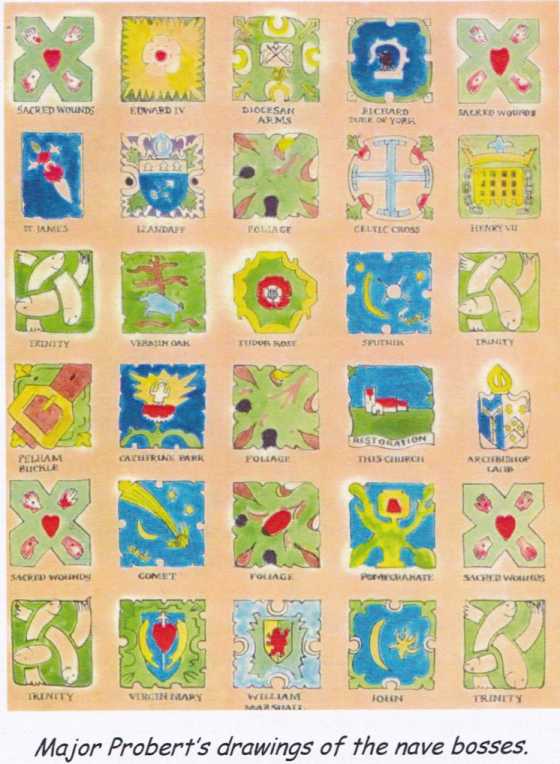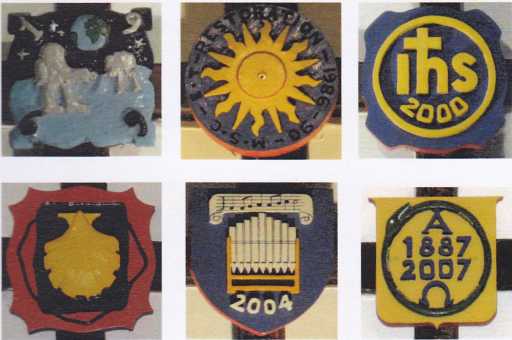In 2003, photographs of the roof bosses in the chancel were taken by Ron Oakeley of Penallt to add to the parish church records. The following commentary was written at about the same time.
To the architect and the builder, a roof boss is the keystone of vaulting ribs supporting a stone roof, usually ornamentally carved and often painted and gilded. The term now popularly includes the wooden carvings attached to the crossings of ribs supporting a ceiling. Carved stone bosses, simulating foliage, became more and more common as “Gothic” architecture developed. In the 14th century, figure bosses (heraldic, pictorial and symbolic) became as common as carvings of foliage. By the 15th century, itinerant medieval craftsmen were echoing the stone bosses in cathedrals and producing wooden carvings in great variety to decorate the wooden ceiling ribs in parish churches and chapels. (See “Roof Bosses in Medieval Churches” by C.J.P. Cave).
The three main ceilings in the Old Church are barrel or wagon ceilings supported by wooden ribs decorated with carved bosses. The earliest reference to them found so far is in a 1952 report by the church’s architect, A.D. Caroe; but he refers only to the chancel having “fine carved bosses”, with no hint of age or origin. Notes left by the late Major Probert of the Argoed refer to “leaving the original ones still remaining in the chancel” when bosses in the nave were repaired or replaced (see below).
The Chancel Bosses
In the 14th and early 15th centuries, recurrent plague and then the incursions of Owen Glendower virtually depopulated south-east Wales. To all appearances, only the lower part of the church tower, the massive north wall of the nave (and possibly of the chancel) and the chancel arch survived the neglect and perhaps deliberate destruction of that time. Recovery was slow and social revival and the possibility of rebuilding the church appear to have been delayed until the mid-15th century at the earliest. The architectural style of the chancel, like that of the nave arcade and the south aisle, is that of the second half of the 15th century and the chancel roof bosses are probably of the same period. Any time much later than this would have seen at least some of the representative Christian symbols or heraldic devices, as in the nave. But only two are “representational” – one resembling the head of a domestic pig, and the other a “castle” or stone gateway with a cloud of smoke issuing from the roof. The majority represent flowers and foliage, notoriously difficult to identify unless they include recognisable fruit such as grapes or acorns. Two of the foliate bosses resemble the Tudor rose – one with six petals instead of the usual five and another with only four. Some incorporate vine leaves but most of them appear simply to be decorative works.
We cannot of course be sure that some of the chancel bosses are not replacements, although a parish appeal leaflet of 1968 calls them “original.” The same leaflet also describes them as “recently restored.” This “restoration” may have included repainting, judging by the harshness and uniformity of the colours we see today.
An intriguing feature of the chancel ceiling is the upper (narrower) pair of horizontal wooden beams or friezes above the north and south walls; they appear to have been inserted or attached after the bosses had been put in place. It is otherwise difficult to explain the two rows of half-bosses, for they add minimal decoration to the ceiling; but they could be the remnants of existing bosses which were sawn in two in situ to accommodate the two beams. Another possibility is that these half-bosses are the remains of bosses damaged when the nave ceiling collapsed in the 1950’s, but rescued and repaired and put up in the chancel to avoid wasting them.
The Nave Bosses
In 1951 the plaster ceiling of the nave collapsed. At the time, the architect and Major Probert (and no doubt other parishioners) were working on the building which had fallen into disrepair during the second world war. The Major’s notes of the work tells us that when the plaster fell “a splendid barrel ceiling” was exposed. It needed repair and while the scaffolding was in place, the opportunity was taken “to replace the bosses.” The notes continue, “Fortunately I had some from Pembridge Castle and our Churchwarden, Mr. Platt, turned out to be a splendid wood-carver and we were able to replace the bosses in the nave.
I did some, such as the inter-twined fishes and the pierced hands and some of the Arms of very distinguished and Royal lords of Gwent….We also did world events such as the Comet” (not Halley’s) “and the Sputnik” (the Russian earth satellite launched in 1957) “and very much later the first Men on the Moon, all painted in suitable colours.” The bosses from Pembridge could be medieval survivals but unfortunately we do not know which these are. A contemporary key to all the nave bosses hangs on the west wall.
The South Aisle
There are six bosses. The first, at the east end, was put up in 1969 by Major Probert to commemorate the landing of men on the moon. Twenty years later, Penallt Church Council decided to mark the completion of restoration work with a boss showing the traditional “rising sun” or Resurgam. The end of the millennium was celebrated when the “IHS 2000” boss was designed and donated by a parishioner and a year later Mrs. Dorothy Lloyd, who had followed in the footsteps of others from the parish, marked her visit to Compostela with a boss showing the pilgrim’s scrip (wallet) and scallop shell of James the Great.
The fifth marks the installation in 2004 of the modern organ and features a stylised version of a mediaeval church organ below a quotation from the Kyrie of the Parish Ferial Mass of David Murray, the church organist. The sixth is a Tudor Shield with a snake (eternity) surrounding Alpha and Omega (the beginning and the end) and the dates (1887 and 2007) when the parish of Penallt was separated from and merged again with that of neighbouring Trellech. All, except the first, were made by a local joiner, Martin Walker, to the designs of a parishioner who sought to echo the spirit of those whose work decorates the ceilings in the chancel and the nave.

[from: Penallt Revisited]